Understanding Drug Therapy for Non-Small Cell Lung Cancer
VerifiedAdded on 2023/03/23
|15
|4854
|35
AI Summary
This document provides an in-depth understanding of drug therapy for non-small cell lung cancer, including its mode of action, side effects, and the specific drugs used. It also discusses the role of chemotherapy and immunotherapy in treating lung cancer. Study material and assignments on this topic are available on Desklib.
Contribute Materials
Your contribution can guide someone’s learning journey. Share your
documents today.
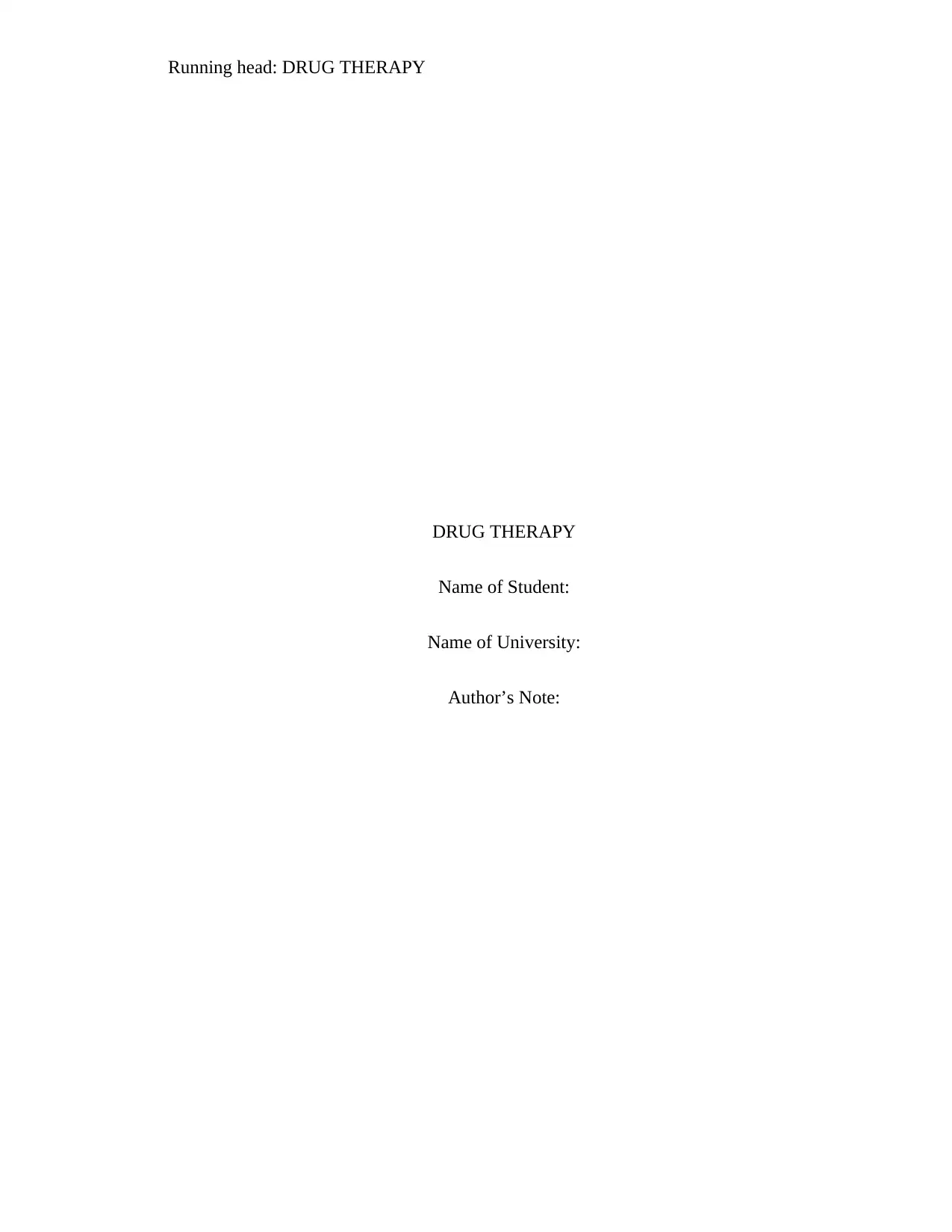
Running head: DRUG THERAPY
DRUG THERAPY
Name of Student:
Name of University:
Author’s Note:
DRUG THERAPY
Name of Student:
Name of University:
Author’s Note:
Secure Best Marks with AI Grader
Need help grading? Try our AI Grader for instant feedback on your assignments.
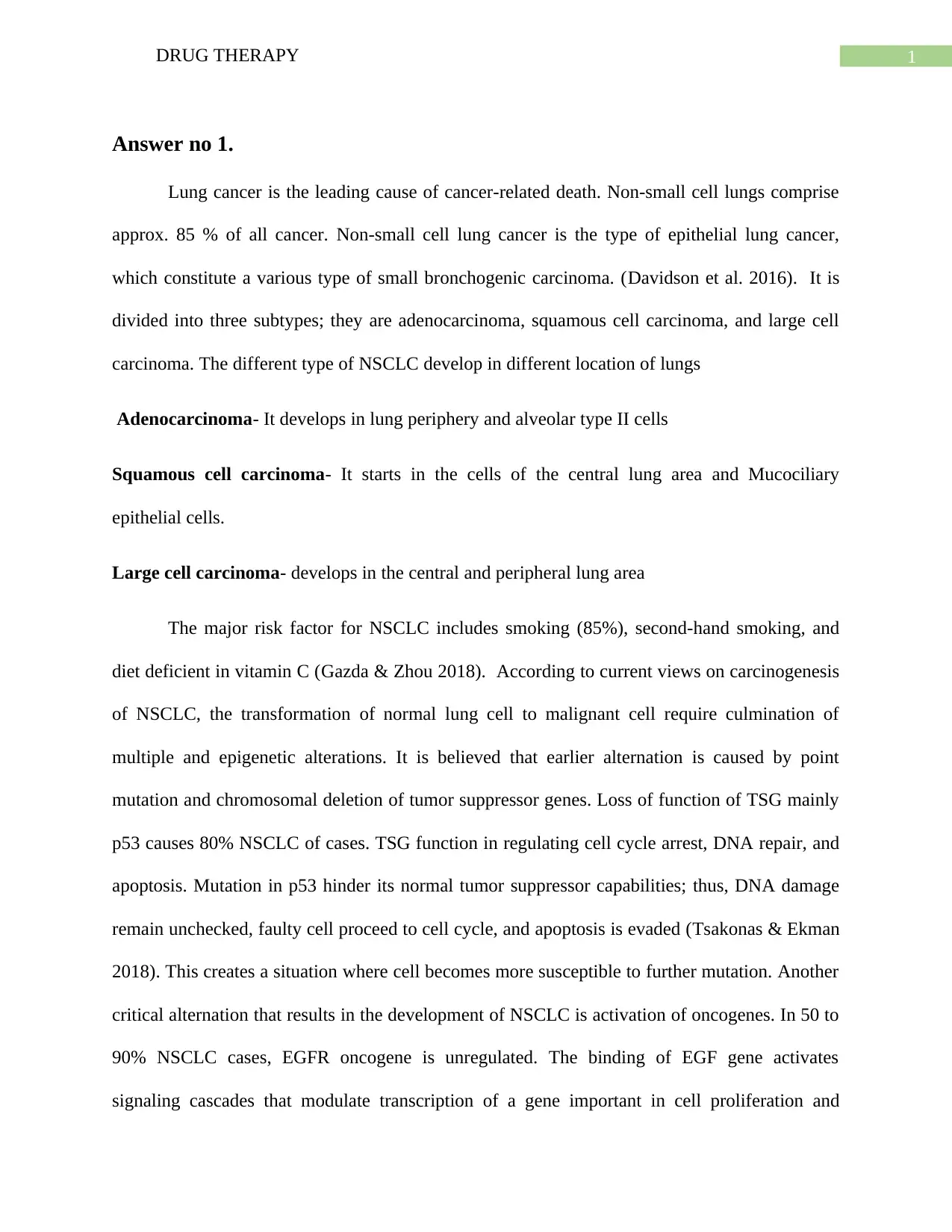
1DRUG THERAPY
Answer no 1.
Lung cancer is the leading cause of cancer-related death. Non-small cell lungs comprise
approx. 85 % of all cancer. Non-small cell lung cancer is the type of epithelial lung cancer,
which constitute a various type of small bronchogenic carcinoma. (Davidson et al. 2016). It is
divided into three subtypes; they are adenocarcinoma, squamous cell carcinoma, and large cell
carcinoma. The different type of NSCLC develop in different location of lungs
Adenocarcinoma- It develops in lung periphery and alveolar type II cells
Squamous cell carcinoma- It starts in the cells of the central lung area and Mucociliary
epithelial cells.
Large cell carcinoma- develops in the central and peripheral lung area
The major risk factor for NSCLC includes smoking (85%), second-hand smoking, and
diet deficient in vitamin C (Gazda & Zhou 2018). According to current views on carcinogenesis
of NSCLC, the transformation of normal lung cell to malignant cell require culmination of
multiple and epigenetic alterations. It is believed that earlier alternation is caused by point
mutation and chromosomal deletion of tumor suppressor genes. Loss of function of TSG mainly
p53 causes 80% NSCLC of cases. TSG function in regulating cell cycle arrest, DNA repair, and
apoptosis. Mutation in p53 hinder its normal tumor suppressor capabilities; thus, DNA damage
remain unchecked, faulty cell proceed to cell cycle, and apoptosis is evaded (Tsakonas & Ekman
2018). This creates a situation where cell becomes more susceptible to further mutation. Another
critical alternation that results in the development of NSCLC is activation of oncogenes. In 50 to
90% NSCLC cases, EGFR oncogene is unregulated. The binding of EGF gene activates
signaling cascades that modulate transcription of a gene important in cell proliferation and
Answer no 1.
Lung cancer is the leading cause of cancer-related death. Non-small cell lungs comprise
approx. 85 % of all cancer. Non-small cell lung cancer is the type of epithelial lung cancer,
which constitute a various type of small bronchogenic carcinoma. (Davidson et al. 2016). It is
divided into three subtypes; they are adenocarcinoma, squamous cell carcinoma, and large cell
carcinoma. The different type of NSCLC develop in different location of lungs
Adenocarcinoma- It develops in lung periphery and alveolar type II cells
Squamous cell carcinoma- It starts in the cells of the central lung area and Mucociliary
epithelial cells.
Large cell carcinoma- develops in the central and peripheral lung area
The major risk factor for NSCLC includes smoking (85%), second-hand smoking, and
diet deficient in vitamin C (Gazda & Zhou 2018). According to current views on carcinogenesis
of NSCLC, the transformation of normal lung cell to malignant cell require culmination of
multiple and epigenetic alterations. It is believed that earlier alternation is caused by point
mutation and chromosomal deletion of tumor suppressor genes. Loss of function of TSG mainly
p53 causes 80% NSCLC of cases. TSG function in regulating cell cycle arrest, DNA repair, and
apoptosis. Mutation in p53 hinder its normal tumor suppressor capabilities; thus, DNA damage
remain unchecked, faulty cell proceed to cell cycle, and apoptosis is evaded (Tsakonas & Ekman
2018). This creates a situation where cell becomes more susceptible to further mutation. Another
critical alternation that results in the development of NSCLC is activation of oncogenes. In 50 to
90% NSCLC cases, EGFR oncogene is unregulated. The binding of EGF gene activates
signaling cascades that modulate transcription of a gene important in cell proliferation and

2DRUG THERAPY
resistance to apoptosis. In the majority of lung cancer, the activation of telomerase is detected
(Marien et al. 2015). Telomerase is hexameric nucleotide repeats that protect the end of the
chromosome from separating. It shortens with each cell division, limited cell proliferation
(Furtado et al. 2015). However, by polymerization of telomerase can contribute to prolonging
cell survival. The malignant cell proliferates and escapes programmed cell death. The lung tumor
makes ups the fluid that builds in the lungs spaces that surround it.
Further, it pushes the air out of the lungs and results in the collapse of the lungs. Due to
this, oxygen is unable to get into the lungs, and passage of carbon dioxide from the lungs is
blocked. This causes difficulty in breathing or shortness of breath.
NSCLC spread to other body parts by the process known as metastasis (Vizoso et al.
2015). It metastases through tissue, lymph, and blood. It spread to a different location in the
lungs causes various type of NSCLC. In order to metastases, tumor cell requires adequate blood
supplies and consequently promotes angiogenesis by producing VEGF. It binds to VEGF
receptor present in epithelial cells of the lungs and leads to the formation of new blood vessels as
NSCLC advances it metastases to another area of lungs and other organs like brain, liver, and
bones.
Answer no 2.
The chemotherapy medication is the combination of drug given to the cancer patients,
which reflects that the patient receives more than two medicines at the same time (Phillips et al.
2016). The pharmacokinetics of the drugs given to Nigel for the treatment of secondary liver
cancer helps to understand its metabolism and how body causes changes in medications which
explains its analysis, distribution, metabolism, and excretion.
resistance to apoptosis. In the majority of lung cancer, the activation of telomerase is detected
(Marien et al. 2015). Telomerase is hexameric nucleotide repeats that protect the end of the
chromosome from separating. It shortens with each cell division, limited cell proliferation
(Furtado et al. 2015). However, by polymerization of telomerase can contribute to prolonging
cell survival. The malignant cell proliferates and escapes programmed cell death. The lung tumor
makes ups the fluid that builds in the lungs spaces that surround it.
Further, it pushes the air out of the lungs and results in the collapse of the lungs. Due to
this, oxygen is unable to get into the lungs, and passage of carbon dioxide from the lungs is
blocked. This causes difficulty in breathing or shortness of breath.
NSCLC spread to other body parts by the process known as metastasis (Vizoso et al.
2015). It metastases through tissue, lymph, and blood. It spread to a different location in the
lungs causes various type of NSCLC. In order to metastases, tumor cell requires adequate blood
supplies and consequently promotes angiogenesis by producing VEGF. It binds to VEGF
receptor present in epithelial cells of the lungs and leads to the formation of new blood vessels as
NSCLC advances it metastases to another area of lungs and other organs like brain, liver, and
bones.
Answer no 2.
The chemotherapy medication is the combination of drug given to the cancer patients,
which reflects that the patient receives more than two medicines at the same time (Phillips et al.
2016). The pharmacokinetics of the drugs given to Nigel for the treatment of secondary liver
cancer helps to understand its metabolism and how body causes changes in medications which
explains its analysis, distribution, metabolism, and excretion.

3DRUG THERAPY
It helps to understand the route of administration and concentration of dose that should
be given to the treatment. As Nigel is having secondary liver cancer, the current medication
given to him is Cisplatin and Docetaxel, which is used for adjuvant therapy. They are known to
treat various malignancies and limit the spread of cancerous cells (Kinoshita et al. 2015). This
drug can be administered both intravenously and orally.
The absorption of Cisplatin and Docetaxel drugs depends on their bioavailability. The
drug given to the patient is through intravenous mode, which has to increase its variability
because it has undergone the process of being transported across the intestine and then passes to
the liver and then enter the systematic plasma circulation (Shukuya et al. 2015). These steps are
known as pharmacokinetic, which involve the absorption, first pass metabolism, and its
elimination before entering the circulation pathway.
The metabolism of the drug given to the patient undergoes hepatic first pass pathways
(Zhang et al. 2019). Metabolism occurs in the liver as the drug is semi-synthetic taxane, which
gets excreted through feces (Sohail et al. 2018). The drugs get demethylated by the cytochrome
P450 3A subfamily, which includes CYP3A4 and CYP3A5. CYP34A are involved in a greater
extent and CYP3A5 lo less extent. Apart from this, CYP1A2 is intricate as a minor enzymatic
component in the process of metabolism. The metabolism is mainly caused oxidation reaction in
the side chain of tert-butylpropionate and result in alcohol docetaxel M2. The metabolite of drug
are formed by cyclisation of M2 and form M3, M1 M4 (Nieuweboer et al. 2015).
The drug then passes through the apical membrane of enterocyte. The ABC transporter
mainly ABCB1 and ABCC2 are involved in the intestinal first pass metabolism by the
metabolizing enzyme. They causes efflux of some part of drug back to intestine and some part of
the drug are absorbed into the mesenteric blood circulation and then it enters the liver through
It helps to understand the route of administration and concentration of dose that should
be given to the treatment. As Nigel is having secondary liver cancer, the current medication
given to him is Cisplatin and Docetaxel, which is used for adjuvant therapy. They are known to
treat various malignancies and limit the spread of cancerous cells (Kinoshita et al. 2015). This
drug can be administered both intravenously and orally.
The absorption of Cisplatin and Docetaxel drugs depends on their bioavailability. The
drug given to the patient is through intravenous mode, which has to increase its variability
because it has undergone the process of being transported across the intestine and then passes to
the liver and then enter the systematic plasma circulation (Shukuya et al. 2015). These steps are
known as pharmacokinetic, which involve the absorption, first pass metabolism, and its
elimination before entering the circulation pathway.
The metabolism of the drug given to the patient undergoes hepatic first pass pathways
(Zhang et al. 2019). Metabolism occurs in the liver as the drug is semi-synthetic taxane, which
gets excreted through feces (Sohail et al. 2018). The drugs get demethylated by the cytochrome
P450 3A subfamily, which includes CYP3A4 and CYP3A5. CYP34A are involved in a greater
extent and CYP3A5 lo less extent. Apart from this, CYP1A2 is intricate as a minor enzymatic
component in the process of metabolism. The metabolism is mainly caused oxidation reaction in
the side chain of tert-butylpropionate and result in alcohol docetaxel M2. The metabolite of drug
are formed by cyclisation of M2 and form M3, M1 M4 (Nieuweboer et al. 2015).
The drug then passes through the apical membrane of enterocyte. The ABC transporter
mainly ABCB1 and ABCC2 are involved in the intestinal first pass metabolism by the
metabolizing enzyme. They causes efflux of some part of drug back to intestine and some part of
the drug are absorbed into the mesenteric blood circulation and then it enters the liver through
Secure Best Marks with AI Grader
Need help grading? Try our AI Grader for instant feedback on your assignments.
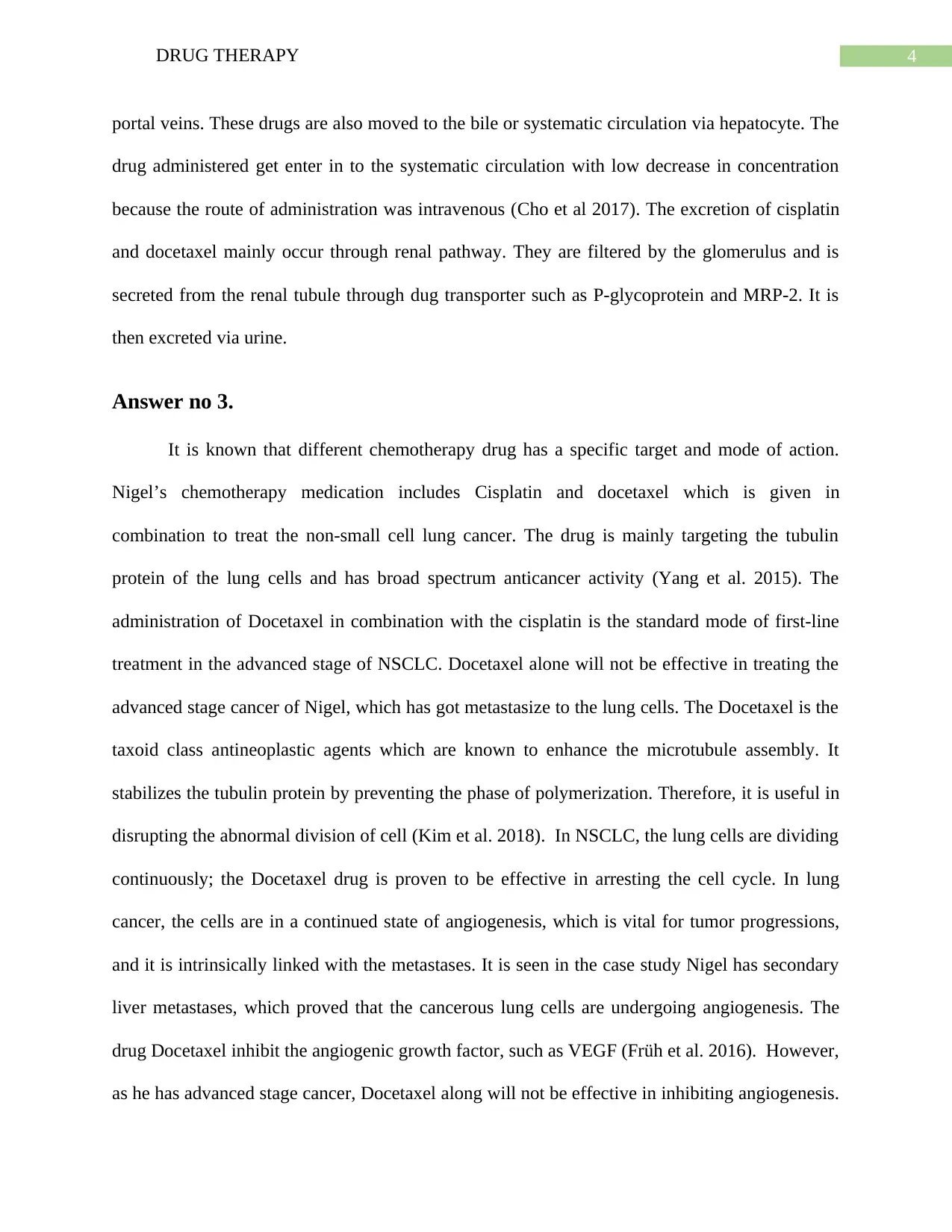
4DRUG THERAPY
portal veins. These drugs are also moved to the bile or systematic circulation via hepatocyte. The
drug administered get enter in to the systematic circulation with low decrease in concentration
because the route of administration was intravenous (Cho et al 2017). The excretion of cisplatin
and docetaxel mainly occur through renal pathway. They are filtered by the glomerulus and is
secreted from the renal tubule through dug transporter such as P-glycoprotein and MRP-2. It is
then excreted via urine.
Answer no 3.
It is known that different chemotherapy drug has a specific target and mode of action.
Nigel’s chemotherapy medication includes Cisplatin and docetaxel which is given in
combination to treat the non-small cell lung cancer. The drug is mainly targeting the tubulin
protein of the lung cells and has broad spectrum anticancer activity (Yang et al. 2015). The
administration of Docetaxel in combination with the cisplatin is the standard mode of first-line
treatment in the advanced stage of NSCLC. Docetaxel alone will not be effective in treating the
advanced stage cancer of Nigel, which has got metastasize to the lung cells. The Docetaxel is the
taxoid class antineoplastic agents which are known to enhance the microtubule assembly. It
stabilizes the tubulin protein by preventing the phase of polymerization. Therefore, it is useful in
disrupting the abnormal division of cell (Kim et al. 2018). In NSCLC, the lung cells are dividing
continuously; the Docetaxel drug is proven to be effective in arresting the cell cycle. In lung
cancer, the cells are in a continued state of angiogenesis, which is vital for tumor progressions,
and it is intrinsically linked with the metastases. It is seen in the case study Nigel has secondary
liver metastases, which proved that the cancerous lung cells are undergoing angiogenesis. The
drug Docetaxel inhibit the angiogenic growth factor, such as VEGF (Früh et al. 2016). However,
as he has advanced stage cancer, Docetaxel along will not be effective in inhibiting angiogenesis.
portal veins. These drugs are also moved to the bile or systematic circulation via hepatocyte. The
drug administered get enter in to the systematic circulation with low decrease in concentration
because the route of administration was intravenous (Cho et al 2017). The excretion of cisplatin
and docetaxel mainly occur through renal pathway. They are filtered by the glomerulus and is
secreted from the renal tubule through dug transporter such as P-glycoprotein and MRP-2. It is
then excreted via urine.
Answer no 3.
It is known that different chemotherapy drug has a specific target and mode of action.
Nigel’s chemotherapy medication includes Cisplatin and docetaxel which is given in
combination to treat the non-small cell lung cancer. The drug is mainly targeting the tubulin
protein of the lung cells and has broad spectrum anticancer activity (Yang et al. 2015). The
administration of Docetaxel in combination with the cisplatin is the standard mode of first-line
treatment in the advanced stage of NSCLC. Docetaxel alone will not be effective in treating the
advanced stage cancer of Nigel, which has got metastasize to the lung cells. The Docetaxel is the
taxoid class antineoplastic agents which are known to enhance the microtubule assembly. It
stabilizes the tubulin protein by preventing the phase of polymerization. Therefore, it is useful in
disrupting the abnormal division of cell (Kim et al. 2018). In NSCLC, the lung cells are dividing
continuously; the Docetaxel drug is proven to be effective in arresting the cell cycle. In lung
cancer, the cells are in a continued state of angiogenesis, which is vital for tumor progressions,
and it is intrinsically linked with the metastases. It is seen in the case study Nigel has secondary
liver metastases, which proved that the cancerous lung cells are undergoing angiogenesis. The
drug Docetaxel inhibit the angiogenic growth factor, such as VEGF (Früh et al. 2016). However,
as he has advanced stage cancer, Docetaxel along will not be effective in inhibiting angiogenesis.
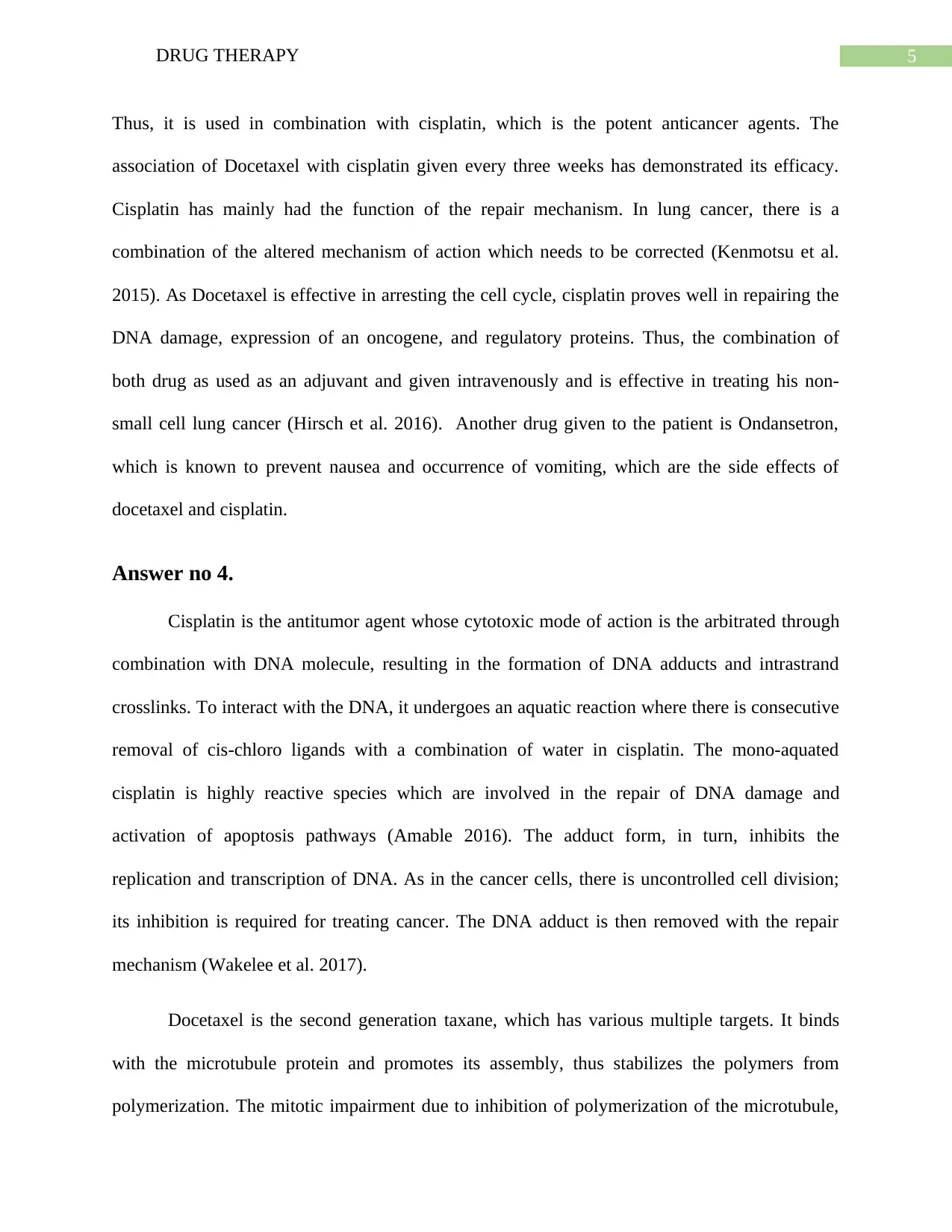
5DRUG THERAPY
Thus, it is used in combination with cisplatin, which is the potent anticancer agents. The
association of Docetaxel with cisplatin given every three weeks has demonstrated its efficacy.
Cisplatin has mainly had the function of the repair mechanism. In lung cancer, there is a
combination of the altered mechanism of action which needs to be corrected (Kenmotsu et al.
2015). As Docetaxel is effective in arresting the cell cycle, cisplatin proves well in repairing the
DNA damage, expression of an oncogene, and regulatory proteins. Thus, the combination of
both drug as used as an adjuvant and given intravenously and is effective in treating his non-
small cell lung cancer (Hirsch et al. 2016). Another drug given to the patient is Ondansetron,
which is known to prevent nausea and occurrence of vomiting, which are the side effects of
docetaxel and cisplatin.
Answer no 4.
Cisplatin is the antitumor agent whose cytotoxic mode of action is the arbitrated through
combination with DNA molecule, resulting in the formation of DNA adducts and intrastrand
crosslinks. To interact with the DNA, it undergoes an aquatic reaction where there is consecutive
removal of cis-chloro ligands with a combination of water in cisplatin. The mono-aquated
cisplatin is highly reactive species which are involved in the repair of DNA damage and
activation of apoptosis pathways (Amable 2016). The adduct form, in turn, inhibits the
replication and transcription of DNA. As in the cancer cells, there is uncontrolled cell division;
its inhibition is required for treating cancer. The DNA adduct is then removed with the repair
mechanism (Wakelee et al. 2017).
Docetaxel is the second generation taxane, which has various multiple targets. It binds
with the microtubule protein and promotes its assembly, thus stabilizes the polymers from
polymerization. The mitotic impairment due to inhibition of polymerization of the microtubule,
Thus, it is used in combination with cisplatin, which is the potent anticancer agents. The
association of Docetaxel with cisplatin given every three weeks has demonstrated its efficacy.
Cisplatin has mainly had the function of the repair mechanism. In lung cancer, there is a
combination of the altered mechanism of action which needs to be corrected (Kenmotsu et al.
2015). As Docetaxel is effective in arresting the cell cycle, cisplatin proves well in repairing the
DNA damage, expression of an oncogene, and regulatory proteins. Thus, the combination of
both drug as used as an adjuvant and given intravenously and is effective in treating his non-
small cell lung cancer (Hirsch et al. 2016). Another drug given to the patient is Ondansetron,
which is known to prevent nausea and occurrence of vomiting, which are the side effects of
docetaxel and cisplatin.
Answer no 4.
Cisplatin is the antitumor agent whose cytotoxic mode of action is the arbitrated through
combination with DNA molecule, resulting in the formation of DNA adducts and intrastrand
crosslinks. To interact with the DNA, it undergoes an aquatic reaction where there is consecutive
removal of cis-chloro ligands with a combination of water in cisplatin. The mono-aquated
cisplatin is highly reactive species which are involved in the repair of DNA damage and
activation of apoptosis pathways (Amable 2016). The adduct form, in turn, inhibits the
replication and transcription of DNA. As in the cancer cells, there is uncontrolled cell division;
its inhibition is required for treating cancer. The DNA adduct is then removed with the repair
mechanism (Wakelee et al. 2017).
Docetaxel is the second generation taxane, which has various multiple targets. It binds
with the microtubule protein and promotes its assembly, thus stabilizes the polymers from
polymerization. The mitotic impairment due to inhibition of polymerization of the microtubule,
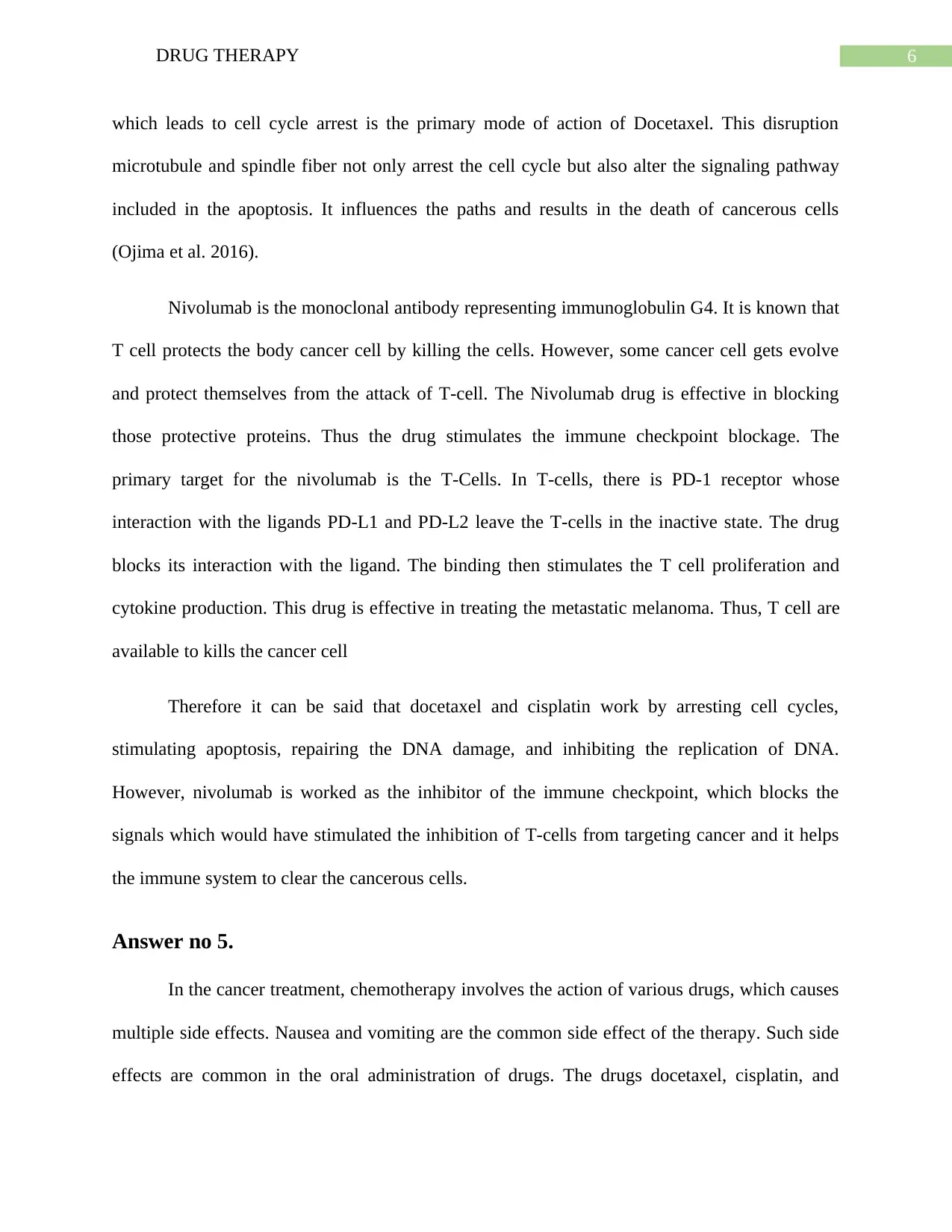
6DRUG THERAPY
which leads to cell cycle arrest is the primary mode of action of Docetaxel. This disruption
microtubule and spindle fiber not only arrest the cell cycle but also alter the signaling pathway
included in the apoptosis. It influences the paths and results in the death of cancerous cells
(Ojima et al. 2016).
Nivolumab is the monoclonal antibody representing immunoglobulin G4. It is known that
T cell protects the body cancer cell by killing the cells. However, some cancer cell gets evolve
and protect themselves from the attack of T-cell. The Nivolumab drug is effective in blocking
those protective proteins. Thus the drug stimulates the immune checkpoint blockage. The
primary target for the nivolumab is the T-Cells. In T-cells, there is PD-1 receptor whose
interaction with the ligands PD-L1 and PD-L2 leave the T-cells in the inactive state. The drug
blocks its interaction with the ligand. The binding then stimulates the T cell proliferation and
cytokine production. This drug is effective in treating the metastatic melanoma. Thus, T cell are
available to kills the cancer cell
Therefore it can be said that docetaxel and cisplatin work by arresting cell cycles,
stimulating apoptosis, repairing the DNA damage, and inhibiting the replication of DNA.
However, nivolumab is worked as the inhibitor of the immune checkpoint, which blocks the
signals which would have stimulated the inhibition of T-cells from targeting cancer and it helps
the immune system to clear the cancerous cells.
Answer no 5.
In the cancer treatment, chemotherapy involves the action of various drugs, which causes
multiple side effects. Nausea and vomiting are the common side effect of the therapy. Such side
effects are common in the oral administration of drugs. The drugs docetaxel, cisplatin, and
which leads to cell cycle arrest is the primary mode of action of Docetaxel. This disruption
microtubule and spindle fiber not only arrest the cell cycle but also alter the signaling pathway
included in the apoptosis. It influences the paths and results in the death of cancerous cells
(Ojima et al. 2016).
Nivolumab is the monoclonal antibody representing immunoglobulin G4. It is known that
T cell protects the body cancer cell by killing the cells. However, some cancer cell gets evolve
and protect themselves from the attack of T-cell. The Nivolumab drug is effective in blocking
those protective proteins. Thus the drug stimulates the immune checkpoint blockage. The
primary target for the nivolumab is the T-Cells. In T-cells, there is PD-1 receptor whose
interaction with the ligands PD-L1 and PD-L2 leave the T-cells in the inactive state. The drug
blocks its interaction with the ligand. The binding then stimulates the T cell proliferation and
cytokine production. This drug is effective in treating the metastatic melanoma. Thus, T cell are
available to kills the cancer cell
Therefore it can be said that docetaxel and cisplatin work by arresting cell cycles,
stimulating apoptosis, repairing the DNA damage, and inhibiting the replication of DNA.
However, nivolumab is worked as the inhibitor of the immune checkpoint, which blocks the
signals which would have stimulated the inhibition of T-cells from targeting cancer and it helps
the immune system to clear the cancerous cells.
Answer no 5.
In the cancer treatment, chemotherapy involves the action of various drugs, which causes
multiple side effects. Nausea and vomiting are the common side effect of the therapy. Such side
effects are common in the oral administration of drugs. The drugs docetaxel, cisplatin, and
Paraphrase This Document
Need a fresh take? Get an instant paraphrase of this document with our AI Paraphraser
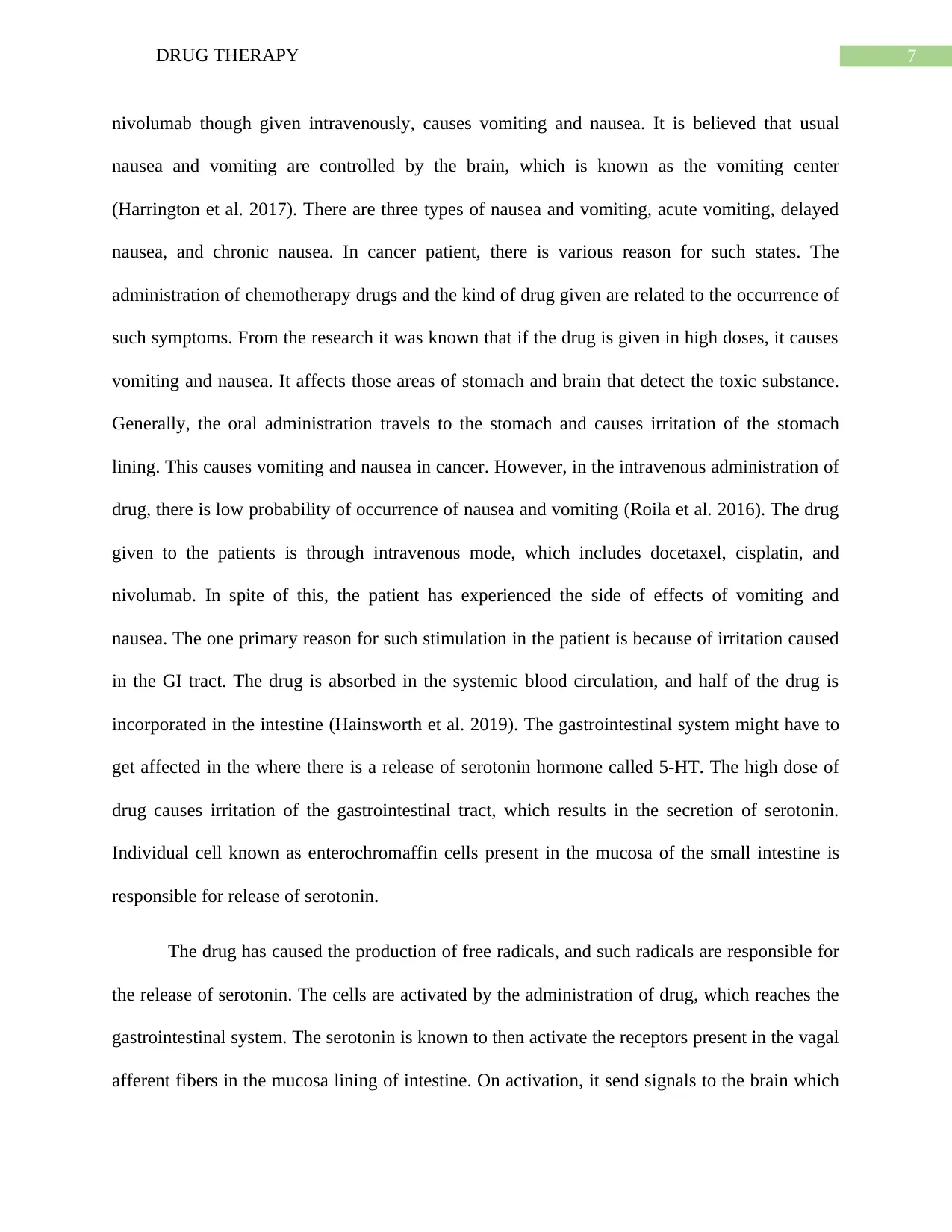
7DRUG THERAPY
nivolumab though given intravenously, causes vomiting and nausea. It is believed that usual
nausea and vomiting are controlled by the brain, which is known as the vomiting center
(Harrington et al. 2017). There are three types of nausea and vomiting, acute vomiting, delayed
nausea, and chronic nausea. In cancer patient, there is various reason for such states. The
administration of chemotherapy drugs and the kind of drug given are related to the occurrence of
such symptoms. From the research it was known that if the drug is given in high doses, it causes
vomiting and nausea. It affects those areas of stomach and brain that detect the toxic substance.
Generally, the oral administration travels to the stomach and causes irritation of the stomach
lining. This causes vomiting and nausea in cancer. However, in the intravenous administration of
drug, there is low probability of occurrence of nausea and vomiting (Roila et al. 2016). The drug
given to the patients is through intravenous mode, which includes docetaxel, cisplatin, and
nivolumab. In spite of this, the patient has experienced the side of effects of vomiting and
nausea. The one primary reason for such stimulation in the patient is because of irritation caused
in the GI tract. The drug is absorbed in the systemic blood circulation, and half of the drug is
incorporated in the intestine (Hainsworth et al. 2019). The gastrointestinal system might have to
get affected in the where there is a release of serotonin hormone called 5-HT. The high dose of
drug causes irritation of the gastrointestinal tract, which results in the secretion of serotonin.
Individual cell known as enterochromaffin cells present in the mucosa of the small intestine is
responsible for release of serotonin.
The drug has caused the production of free radicals, and such radicals are responsible for
the release of serotonin. The cells are activated by the administration of drug, which reaches the
gastrointestinal system. The serotonin is known to then activate the receptors present in the vagal
afferent fibers in the mucosa lining of intestine. On activation, it send signals to the brain which
nivolumab though given intravenously, causes vomiting and nausea. It is believed that usual
nausea and vomiting are controlled by the brain, which is known as the vomiting center
(Harrington et al. 2017). There are three types of nausea and vomiting, acute vomiting, delayed
nausea, and chronic nausea. In cancer patient, there is various reason for such states. The
administration of chemotherapy drugs and the kind of drug given are related to the occurrence of
such symptoms. From the research it was known that if the drug is given in high doses, it causes
vomiting and nausea. It affects those areas of stomach and brain that detect the toxic substance.
Generally, the oral administration travels to the stomach and causes irritation of the stomach
lining. This causes vomiting and nausea in cancer. However, in the intravenous administration of
drug, there is low probability of occurrence of nausea and vomiting (Roila et al. 2016). The drug
given to the patients is through intravenous mode, which includes docetaxel, cisplatin, and
nivolumab. In spite of this, the patient has experienced the side of effects of vomiting and
nausea. The one primary reason for such stimulation in the patient is because of irritation caused
in the GI tract. The drug is absorbed in the systemic blood circulation, and half of the drug is
incorporated in the intestine (Hainsworth et al. 2019). The gastrointestinal system might have to
get affected in the where there is a release of serotonin hormone called 5-HT. The high dose of
drug causes irritation of the gastrointestinal tract, which results in the secretion of serotonin.
Individual cell known as enterochromaffin cells present in the mucosa of the small intestine is
responsible for release of serotonin.
The drug has caused the production of free radicals, and such radicals are responsible for
the release of serotonin. The cells are activated by the administration of drug, which reaches the
gastrointestinal system. The serotonin is known to then activate the receptors present in the vagal
afferent fibers in the mucosa lining of intestine. On activation, it send signals to the brain which
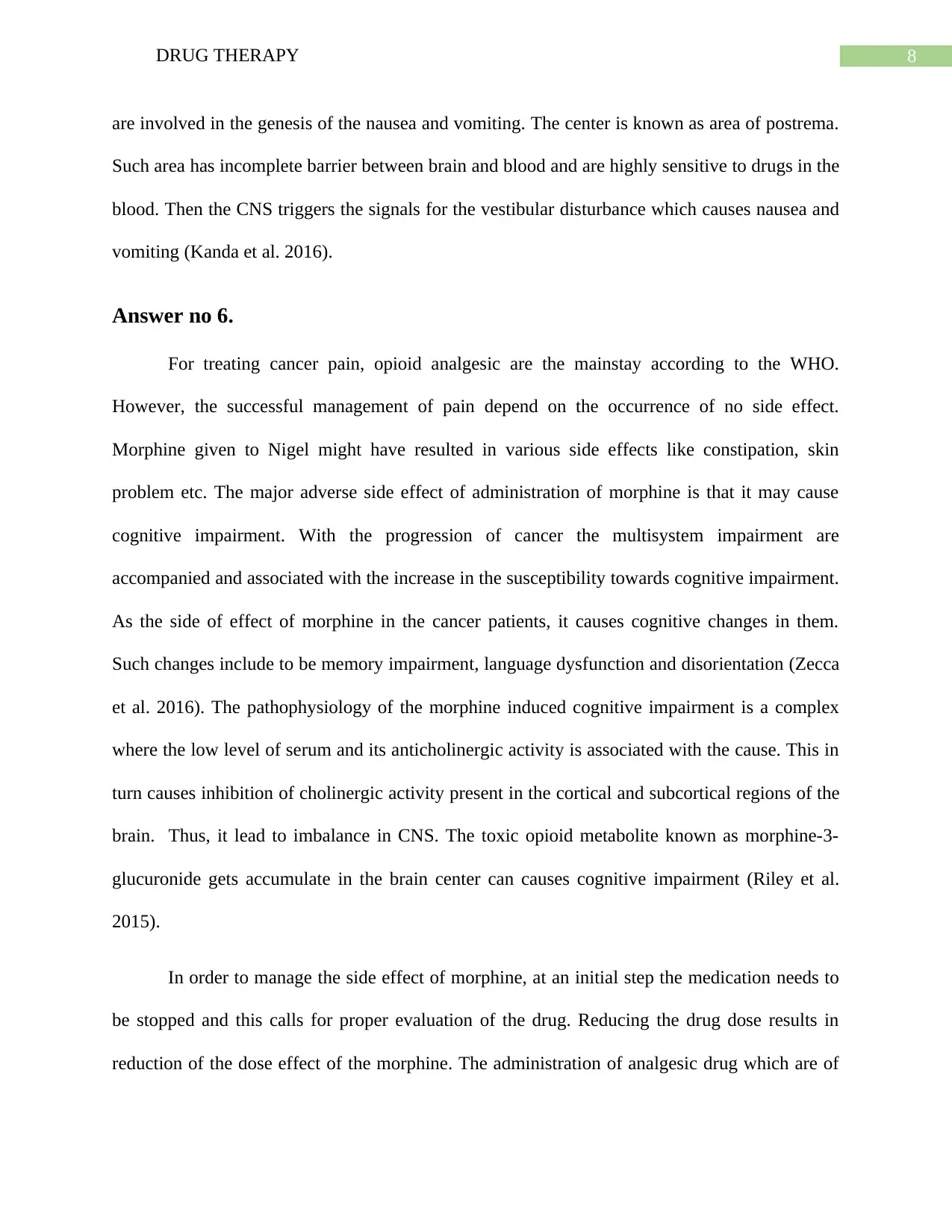
8DRUG THERAPY
are involved in the genesis of the nausea and vomiting. The center is known as area of postrema.
Such area has incomplete barrier between brain and blood and are highly sensitive to drugs in the
blood. Then the CNS triggers the signals for the vestibular disturbance which causes nausea and
vomiting (Kanda et al. 2016).
Answer no 6.
For treating cancer pain, opioid analgesic are the mainstay according to the WHO.
However, the successful management of pain depend on the occurrence of no side effect.
Morphine given to Nigel might have resulted in various side effects like constipation, skin
problem etc. The major adverse side effect of administration of morphine is that it may cause
cognitive impairment. With the progression of cancer the multisystem impairment are
accompanied and associated with the increase in the susceptibility towards cognitive impairment.
As the side of effect of morphine in the cancer patients, it causes cognitive changes in them.
Such changes include to be memory impairment, language dysfunction and disorientation (Zecca
et al. 2016). The pathophysiology of the morphine induced cognitive impairment is a complex
where the low level of serum and its anticholinergic activity is associated with the cause. This in
turn causes inhibition of cholinergic activity present in the cortical and subcortical regions of the
brain. Thus, it lead to imbalance in CNS. The toxic opioid metabolite known as morphine-3-
glucuronide gets accumulate in the brain center can causes cognitive impairment (Riley et al.
2015).
In order to manage the side effect of morphine, at an initial step the medication needs to
be stopped and this calls for proper evaluation of the drug. Reducing the drug dose results in
reduction of the dose effect of the morphine. The administration of analgesic drug which are of
are involved in the genesis of the nausea and vomiting. The center is known as area of postrema.
Such area has incomplete barrier between brain and blood and are highly sensitive to drugs in the
blood. Then the CNS triggers the signals for the vestibular disturbance which causes nausea and
vomiting (Kanda et al. 2016).
Answer no 6.
For treating cancer pain, opioid analgesic are the mainstay according to the WHO.
However, the successful management of pain depend on the occurrence of no side effect.
Morphine given to Nigel might have resulted in various side effects like constipation, skin
problem etc. The major adverse side effect of administration of morphine is that it may cause
cognitive impairment. With the progression of cancer the multisystem impairment are
accompanied and associated with the increase in the susceptibility towards cognitive impairment.
As the side of effect of morphine in the cancer patients, it causes cognitive changes in them.
Such changes include to be memory impairment, language dysfunction and disorientation (Zecca
et al. 2016). The pathophysiology of the morphine induced cognitive impairment is a complex
where the low level of serum and its anticholinergic activity is associated with the cause. This in
turn causes inhibition of cholinergic activity present in the cortical and subcortical regions of the
brain. Thus, it lead to imbalance in CNS. The toxic opioid metabolite known as morphine-3-
glucuronide gets accumulate in the brain center can causes cognitive impairment (Riley et al.
2015).
In order to manage the side effect of morphine, at an initial step the medication needs to
be stopped and this calls for proper evaluation of the drug. Reducing the drug dose results in
reduction of the dose effect of the morphine. The administration of analgesic drug which are of
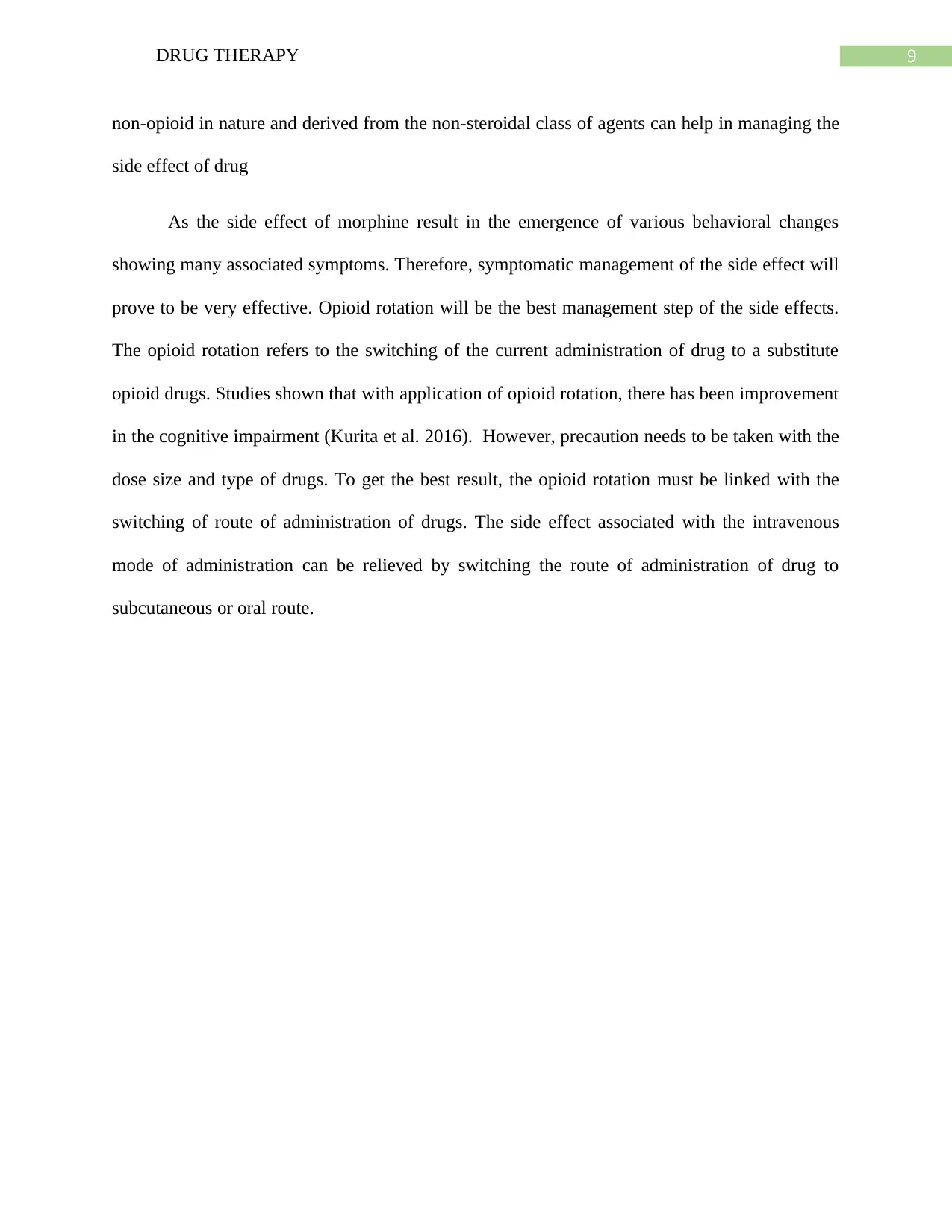
9DRUG THERAPY
non-opioid in nature and derived from the non-steroidal class of agents can help in managing the
side effect of drug
As the side effect of morphine result in the emergence of various behavioral changes
showing many associated symptoms. Therefore, symptomatic management of the side effect will
prove to be very effective. Opioid rotation will be the best management step of the side effects.
The opioid rotation refers to the switching of the current administration of drug to a substitute
opioid drugs. Studies shown that with application of opioid rotation, there has been improvement
in the cognitive impairment (Kurita et al. 2016). However, precaution needs to be taken with the
dose size and type of drugs. To get the best result, the opioid rotation must be linked with the
switching of route of administration of drugs. The side effect associated with the intravenous
mode of administration can be relieved by switching the route of administration of drug to
subcutaneous or oral route.
non-opioid in nature and derived from the non-steroidal class of agents can help in managing the
side effect of drug
As the side effect of morphine result in the emergence of various behavioral changes
showing many associated symptoms. Therefore, symptomatic management of the side effect will
prove to be very effective. Opioid rotation will be the best management step of the side effects.
The opioid rotation refers to the switching of the current administration of drug to a substitute
opioid drugs. Studies shown that with application of opioid rotation, there has been improvement
in the cognitive impairment (Kurita et al. 2016). However, precaution needs to be taken with the
dose size and type of drugs. To get the best result, the opioid rotation must be linked with the
switching of route of administration of drugs. The side effect associated with the intravenous
mode of administration can be relieved by switching the route of administration of drug to
subcutaneous or oral route.
Secure Best Marks with AI Grader
Need help grading? Try our AI Grader for instant feedback on your assignments.

10DRUG THERAPY
Reference
Amable, L., 2016. Cisplatin resistance and opportunities for precision
medicine. Pharmacological research, 106, pp.27-36.
Cho, H., Ryu, M.H., Kim, K.P., Ryoo, B.Y., Park, S.R., Kim, B.S., Lee, I.S., Kim, H.S., Yoo,
M.W., Yook, J.H. & Oh, S.T., 2017. Phase I/II study of a combination of capecitabine, cisplatin,
and intraperitoneal docetaxel (XP ID) in advanced gastric cancer patients with peritoneal
metastasis. Gastric Cancer, 20(6), pp.970-977.
Davidson, S.M., Papagiannakopoulos, T., Olenchock, B.A., Heyman, J.E., Keibler, M.A.,
Luengo, A., Bauer, M.R., Jha, A.K., O’Brien, J.P., Pierce, K.A. .& Gui, D.Y., 2016.
Environment impacts the metabolic dependencies of Ras-driven non-small cell lung cancer. Cell
metabolism, 23(3), pp.517-528.
Früh, M., Ris, H.B., Xyrafas, A., Peters, S., Mirimanoff, R.O., Gautschi, O., Pless, M. .& Stupp,
R., 2016. Preoperative chemoradiotherapy with cisplatin and docetaxel for stage IIIB non-small-
cell lung cancer: 10-year follow-up of the SAKK 16/01 trial. Annals of Oncology, 27(10),
pp.1971-1973.
Furtado, F.M., Matos, D.M., Scatena, N.F., Santana, B., Sheucher, P.S., Rego, E.M., Calado,
R.T. .& Falcao, R.P., 2015. Telomere Dynamics in Monoclonal B-Cell Lymphocytosis and
Binet a Chronic Lymphocytic Leukemia.
Hainsworth, J.D., 2019. Nausea and vomiting. In Abeloff's Clinical Oncology (pp. 598-606).
Content Repository Only!.
Reference
Amable, L., 2016. Cisplatin resistance and opportunities for precision
medicine. Pharmacological research, 106, pp.27-36.
Cho, H., Ryu, M.H., Kim, K.P., Ryoo, B.Y., Park, S.R., Kim, B.S., Lee, I.S., Kim, H.S., Yoo,
M.W., Yook, J.H. & Oh, S.T., 2017. Phase I/II study of a combination of capecitabine, cisplatin,
and intraperitoneal docetaxel (XP ID) in advanced gastric cancer patients with peritoneal
metastasis. Gastric Cancer, 20(6), pp.970-977.
Davidson, S.M., Papagiannakopoulos, T., Olenchock, B.A., Heyman, J.E., Keibler, M.A.,
Luengo, A., Bauer, M.R., Jha, A.K., O’Brien, J.P., Pierce, K.A. .& Gui, D.Y., 2016.
Environment impacts the metabolic dependencies of Ras-driven non-small cell lung cancer. Cell
metabolism, 23(3), pp.517-528.
Früh, M., Ris, H.B., Xyrafas, A., Peters, S., Mirimanoff, R.O., Gautschi, O., Pless, M. .& Stupp,
R., 2016. Preoperative chemoradiotherapy with cisplatin and docetaxel for stage IIIB non-small-
cell lung cancer: 10-year follow-up of the SAKK 16/01 trial. Annals of Oncology, 27(10),
pp.1971-1973.
Furtado, F.M., Matos, D.M., Scatena, N.F., Santana, B., Sheucher, P.S., Rego, E.M., Calado,
R.T. .& Falcao, R.P., 2015. Telomere Dynamics in Monoclonal B-Cell Lymphocytosis and
Binet a Chronic Lymphocytic Leukemia.
Hainsworth, J.D., 2019. Nausea and vomiting. In Abeloff's Clinical Oncology (pp. 598-606).
Content Repository Only!.
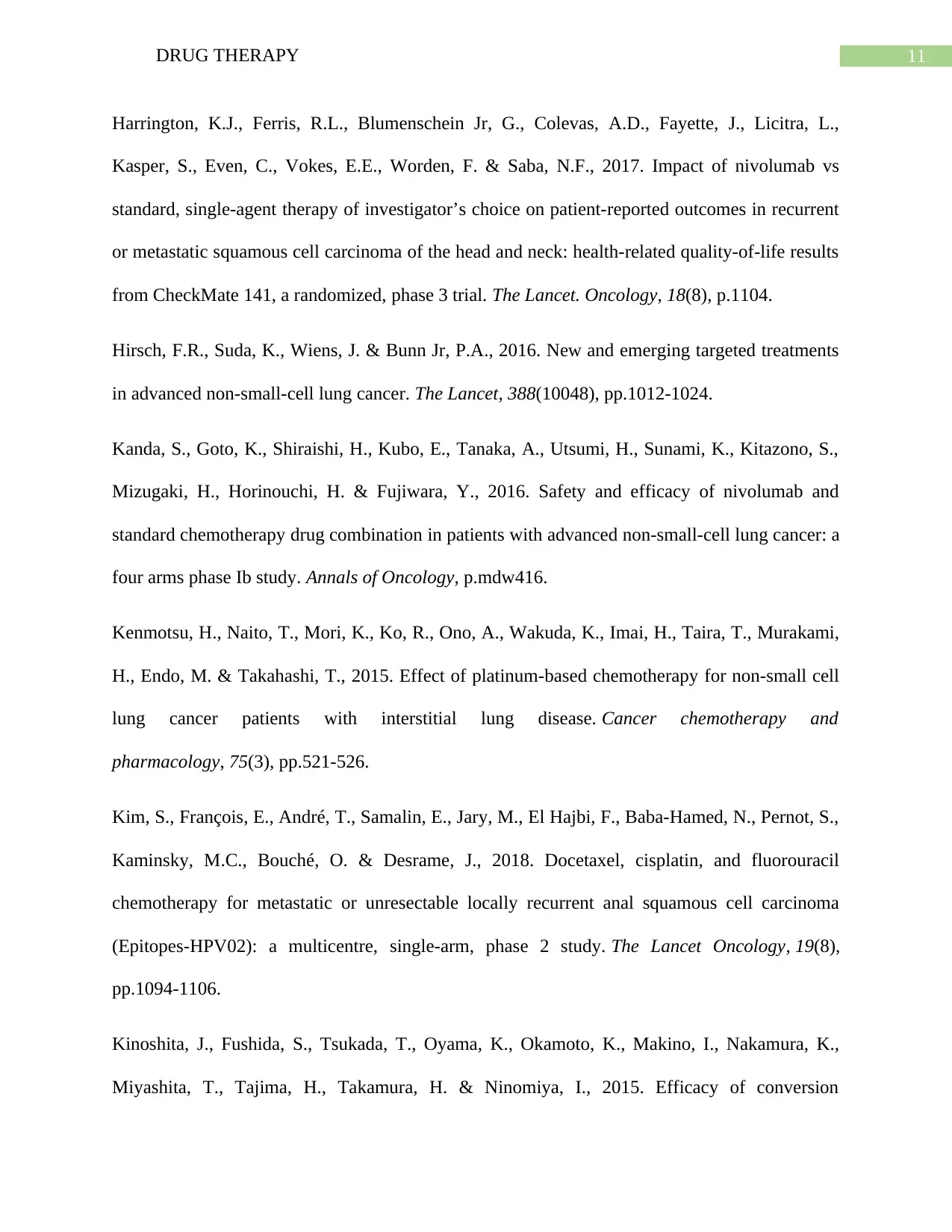
11DRUG THERAPY
Harrington, K.J., Ferris, R.L., Blumenschein Jr, G., Colevas, A.D., Fayette, J., Licitra, L.,
Kasper, S., Even, C., Vokes, E.E., Worden, F. & Saba, N.F., 2017. Impact of nivolumab vs
standard, single-agent therapy of investigator’s choice on patient-reported outcomes in recurrent
or metastatic squamous cell carcinoma of the head and neck: health-related quality-of-life results
from CheckMate 141, a randomized, phase 3 trial. The Lancet. Oncology, 18(8), p.1104.
Hirsch, F.R., Suda, K., Wiens, J. & Bunn Jr, P.A., 2016. New and emerging targeted treatments
in advanced non-small-cell lung cancer. The Lancet, 388(10048), pp.1012-1024.
Kanda, S., Goto, K., Shiraishi, H., Kubo, E., Tanaka, A., Utsumi, H., Sunami, K., Kitazono, S.,
Mizugaki, H., Horinouchi, H. & Fujiwara, Y., 2016. Safety and efficacy of nivolumab and
standard chemotherapy drug combination in patients with advanced non-small-cell lung cancer: a
four arms phase Ib study. Annals of Oncology, p.mdw416.
Kenmotsu, H., Naito, T., Mori, K., Ko, R., Ono, A., Wakuda, K., Imai, H., Taira, T., Murakami,
H., Endo, M. & Takahashi, T., 2015. Effect of platinum-based chemotherapy for non-small cell
lung cancer patients with interstitial lung disease. Cancer chemotherapy and
pharmacology, 75(3), pp.521-526.
Kim, S., François, E., André, T., Samalin, E., Jary, M., El Hajbi, F., Baba-Hamed, N., Pernot, S.,
Kaminsky, M.C., Bouché, O. & Desrame, J., 2018. Docetaxel, cisplatin, and fluorouracil
chemotherapy for metastatic or unresectable locally recurrent anal squamous cell carcinoma
(Epitopes-HPV02): a multicentre, single-arm, phase 2 study. The Lancet Oncology, 19(8),
pp.1094-1106.
Kinoshita, J., Fushida, S., Tsukada, T., Oyama, K., Okamoto, K., Makino, I., Nakamura, K.,
Miyashita, T., Tajima, H., Takamura, H. & Ninomiya, I., 2015. Efficacy of conversion
Harrington, K.J., Ferris, R.L., Blumenschein Jr, G., Colevas, A.D., Fayette, J., Licitra, L.,
Kasper, S., Even, C., Vokes, E.E., Worden, F. & Saba, N.F., 2017. Impact of nivolumab vs
standard, single-agent therapy of investigator’s choice on patient-reported outcomes in recurrent
or metastatic squamous cell carcinoma of the head and neck: health-related quality-of-life results
from CheckMate 141, a randomized, phase 3 trial. The Lancet. Oncology, 18(8), p.1104.
Hirsch, F.R., Suda, K., Wiens, J. & Bunn Jr, P.A., 2016. New and emerging targeted treatments
in advanced non-small-cell lung cancer. The Lancet, 388(10048), pp.1012-1024.
Kanda, S., Goto, K., Shiraishi, H., Kubo, E., Tanaka, A., Utsumi, H., Sunami, K., Kitazono, S.,
Mizugaki, H., Horinouchi, H. & Fujiwara, Y., 2016. Safety and efficacy of nivolumab and
standard chemotherapy drug combination in patients with advanced non-small-cell lung cancer: a
four arms phase Ib study. Annals of Oncology, p.mdw416.
Kenmotsu, H., Naito, T., Mori, K., Ko, R., Ono, A., Wakuda, K., Imai, H., Taira, T., Murakami,
H., Endo, M. & Takahashi, T., 2015. Effect of platinum-based chemotherapy for non-small cell
lung cancer patients with interstitial lung disease. Cancer chemotherapy and
pharmacology, 75(3), pp.521-526.
Kim, S., François, E., André, T., Samalin, E., Jary, M., El Hajbi, F., Baba-Hamed, N., Pernot, S.,
Kaminsky, M.C., Bouché, O. & Desrame, J., 2018. Docetaxel, cisplatin, and fluorouracil
chemotherapy for metastatic or unresectable locally recurrent anal squamous cell carcinoma
(Epitopes-HPV02): a multicentre, single-arm, phase 2 study. The Lancet Oncology, 19(8),
pp.1094-1106.
Kinoshita, J., Fushida, S., Tsukada, T., Oyama, K., Okamoto, K., Makino, I., Nakamura, K.,
Miyashita, T., Tajima, H., Takamura, H. & Ninomiya, I., 2015. Efficacy of conversion

12DRUG THERAPY
gastrectomy following docetaxel, cisplatin, and S-1 therapy in potentially resectable stage IV
gastric cancer. European Journal of Surgical Oncology (EJSO), 41(10), pp.1354-1360.
Kurita, G.P., Ekholm, O., Kaasa, S., Klepstad, P., Skorpen, F. & Sjøgren, P., 2016. Genetic
variation and cognitive dysfunction in opioid‐treated patients with cancer. Brain and
behavior, 6(7), p.e00471.
Lee, C.K., Man, J., Lord, S., Links, M., Gebski, V., Mok, T. & Yang, J.C.H., 2017. Checkpoint
inhibitors in metastatic EGFR-mutated non–small cell lung cancer—a meta-analysis. Journal of
Thoracic Oncology, 12(2), pp.403-407.
Marien, E., Meister, M., Muley, T., Fieuws, S., Bordel, S., Derua, R., Spraggins, J., Van de Plas,
R., Dehairs, J., Wouters, J. & Bagadi, M., 2015. Non‐small cell lung cancer is characterized by
dramatic changes in phospholipid profiles. International Journal of Cancer, 137(7), pp.1539-
1548.
Nieuweboer, A.J., de Morrée, E.S., de Graan, A.J.M., Sparreboom, A., de Wit, R. & Mathijssen,
R.H., 2015. Inter-patient variability in docetaxel pharmacokinetics: a review. Cancer treatment
reviews, 41(7), pp.605-613.
Nieuweboer, A.J., de Morrée, E.S., de Graan, A.J.M., Sparreboom, A., de Wit, R. & Mathijssen,
R.H., 2015. Inter-patient variability in docetaxel pharmacokinetics: a review. Cancer treatment
reviews, 41(7), pp.605-613.
Ojima, I., Lichtenthal, B., Lee, S., Wang, C. & Wang, X., 2016. Taxane anticancer agents: a
patent perspective. Expert opinion on therapeutic patents, 26(1), pp.1-20.
gastrectomy following docetaxel, cisplatin, and S-1 therapy in potentially resectable stage IV
gastric cancer. European Journal of Surgical Oncology (EJSO), 41(10), pp.1354-1360.
Kurita, G.P., Ekholm, O., Kaasa, S., Klepstad, P., Skorpen, F. & Sjøgren, P., 2016. Genetic
variation and cognitive dysfunction in opioid‐treated patients with cancer. Brain and
behavior, 6(7), p.e00471.
Lee, C.K., Man, J., Lord, S., Links, M., Gebski, V., Mok, T. & Yang, J.C.H., 2017. Checkpoint
inhibitors in metastatic EGFR-mutated non–small cell lung cancer—a meta-analysis. Journal of
Thoracic Oncology, 12(2), pp.403-407.
Marien, E., Meister, M., Muley, T., Fieuws, S., Bordel, S., Derua, R., Spraggins, J., Van de Plas,
R., Dehairs, J., Wouters, J. & Bagadi, M., 2015. Non‐small cell lung cancer is characterized by
dramatic changes in phospholipid profiles. International Journal of Cancer, 137(7), pp.1539-
1548.
Nieuweboer, A.J., de Morrée, E.S., de Graan, A.J.M., Sparreboom, A., de Wit, R. & Mathijssen,
R.H., 2015. Inter-patient variability in docetaxel pharmacokinetics: a review. Cancer treatment
reviews, 41(7), pp.605-613.
Nieuweboer, A.J., de Morrée, E.S., de Graan, A.J.M., Sparreboom, A., de Wit, R. & Mathijssen,
R.H., 2015. Inter-patient variability in docetaxel pharmacokinetics: a review. Cancer treatment
reviews, 41(7), pp.605-613.
Ojima, I., Lichtenthal, B., Lee, S., Wang, C. & Wang, X., 2016. Taxane anticancer agents: a
patent perspective. Expert opinion on therapeutic patents, 26(1), pp.1-20.
Paraphrase This Document
Need a fresh take? Get an instant paraphrase of this document with our AI Paraphraser
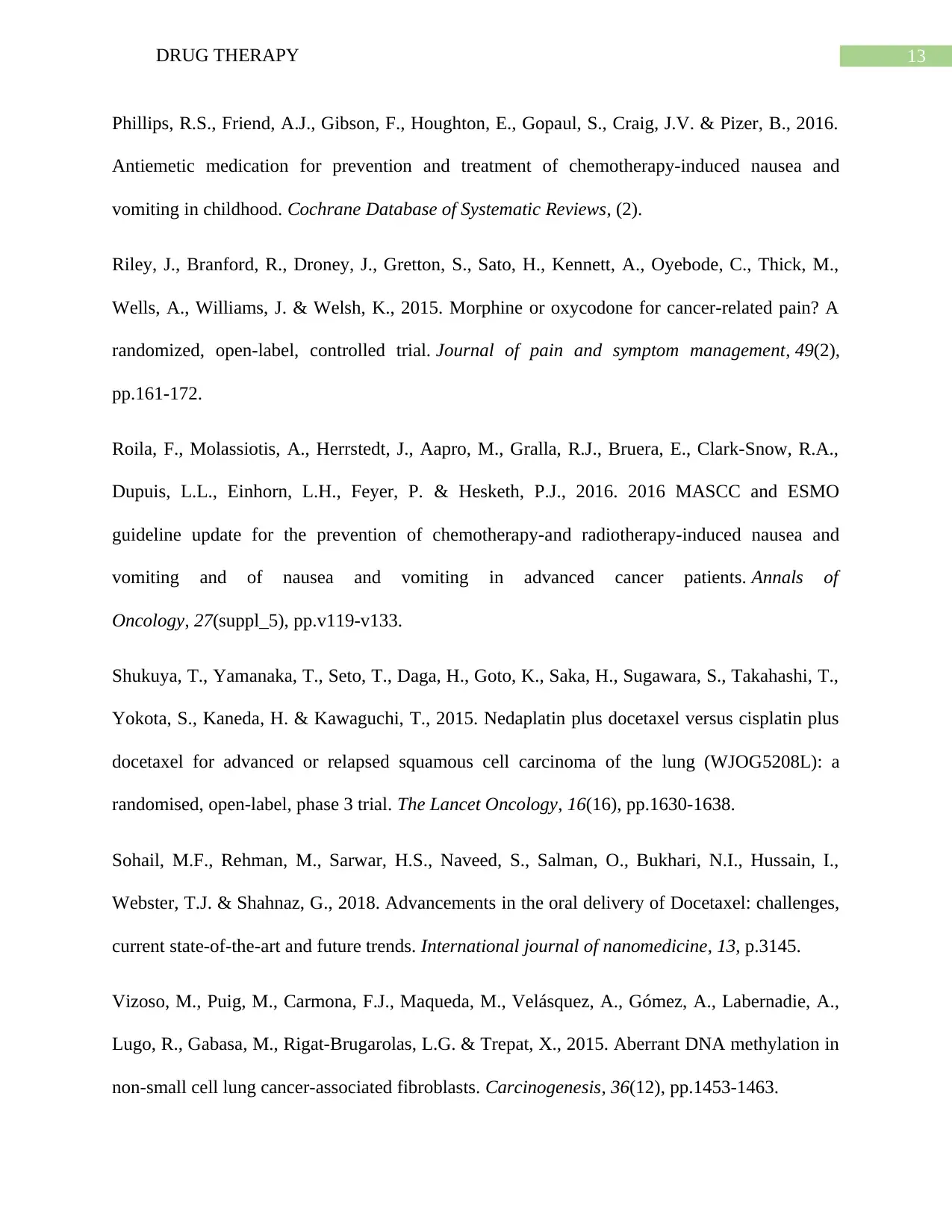
13DRUG THERAPY
Phillips, R.S., Friend, A.J., Gibson, F., Houghton, E., Gopaul, S., Craig, J.V. & Pizer, B., 2016.
Antiemetic medication for prevention and treatment of chemotherapy‐induced nausea and
vomiting in childhood. Cochrane Database of Systematic Reviews, (2).
Riley, J., Branford, R., Droney, J., Gretton, S., Sato, H., Kennett, A., Oyebode, C., Thick, M.,
Wells, A., Williams, J. & Welsh, K., 2015. Morphine or oxycodone for cancer-related pain? A
randomized, open-label, controlled trial. Journal of pain and symptom management, 49(2),
pp.161-172.
Roila, F., Molassiotis, A., Herrstedt, J., Aapro, M., Gralla, R.J., Bruera, E., Clark-Snow, R.A.,
Dupuis, L.L., Einhorn, L.H., Feyer, P. & Hesketh, P.J., 2016. 2016 MASCC and ESMO
guideline update for the prevention of chemotherapy-and radiotherapy-induced nausea and
vomiting and of nausea and vomiting in advanced cancer patients. Annals of
Oncology, 27(suppl_5), pp.v119-v133.
Shukuya, T., Yamanaka, T., Seto, T., Daga, H., Goto, K., Saka, H., Sugawara, S., Takahashi, T.,
Yokota, S., Kaneda, H. & Kawaguchi, T., 2015. Nedaplatin plus docetaxel versus cisplatin plus
docetaxel for advanced or relapsed squamous cell carcinoma of the lung (WJOG5208L): a
randomised, open-label, phase 3 trial. The Lancet Oncology, 16(16), pp.1630-1638.
Sohail, M.F., Rehman, M., Sarwar, H.S., Naveed, S., Salman, O., Bukhari, N.I., Hussain, I.,
Webster, T.J. & Shahnaz, G., 2018. Advancements in the oral delivery of Docetaxel: challenges,
current state-of-the-art and future trends. International journal of nanomedicine, 13, p.3145.
Vizoso, M., Puig, M., Carmona, F.J., Maqueda, M., Velásquez, A., Gómez, A., Labernadie, A.,
Lugo, R., Gabasa, M., Rigat-Brugarolas, L.G. & Trepat, X., 2015. Aberrant DNA methylation in
non-small cell lung cancer-associated fibroblasts. Carcinogenesis, 36(12), pp.1453-1463.
Phillips, R.S., Friend, A.J., Gibson, F., Houghton, E., Gopaul, S., Craig, J.V. & Pizer, B., 2016.
Antiemetic medication for prevention and treatment of chemotherapy‐induced nausea and
vomiting in childhood. Cochrane Database of Systematic Reviews, (2).
Riley, J., Branford, R., Droney, J., Gretton, S., Sato, H., Kennett, A., Oyebode, C., Thick, M.,
Wells, A., Williams, J. & Welsh, K., 2015. Morphine or oxycodone for cancer-related pain? A
randomized, open-label, controlled trial. Journal of pain and symptom management, 49(2),
pp.161-172.
Roila, F., Molassiotis, A., Herrstedt, J., Aapro, M., Gralla, R.J., Bruera, E., Clark-Snow, R.A.,
Dupuis, L.L., Einhorn, L.H., Feyer, P. & Hesketh, P.J., 2016. 2016 MASCC and ESMO
guideline update for the prevention of chemotherapy-and radiotherapy-induced nausea and
vomiting and of nausea and vomiting in advanced cancer patients. Annals of
Oncology, 27(suppl_5), pp.v119-v133.
Shukuya, T., Yamanaka, T., Seto, T., Daga, H., Goto, K., Saka, H., Sugawara, S., Takahashi, T.,
Yokota, S., Kaneda, H. & Kawaguchi, T., 2015. Nedaplatin plus docetaxel versus cisplatin plus
docetaxel for advanced or relapsed squamous cell carcinoma of the lung (WJOG5208L): a
randomised, open-label, phase 3 trial. The Lancet Oncology, 16(16), pp.1630-1638.
Sohail, M.F., Rehman, M., Sarwar, H.S., Naveed, S., Salman, O., Bukhari, N.I., Hussain, I.,
Webster, T.J. & Shahnaz, G., 2018. Advancements in the oral delivery of Docetaxel: challenges,
current state-of-the-art and future trends. International journal of nanomedicine, 13, p.3145.
Vizoso, M., Puig, M., Carmona, F.J., Maqueda, M., Velásquez, A., Gómez, A., Labernadie, A.,
Lugo, R., Gabasa, M., Rigat-Brugarolas, L.G. & Trepat, X., 2015. Aberrant DNA methylation in
non-small cell lung cancer-associated fibroblasts. Carcinogenesis, 36(12), pp.1453-1463.
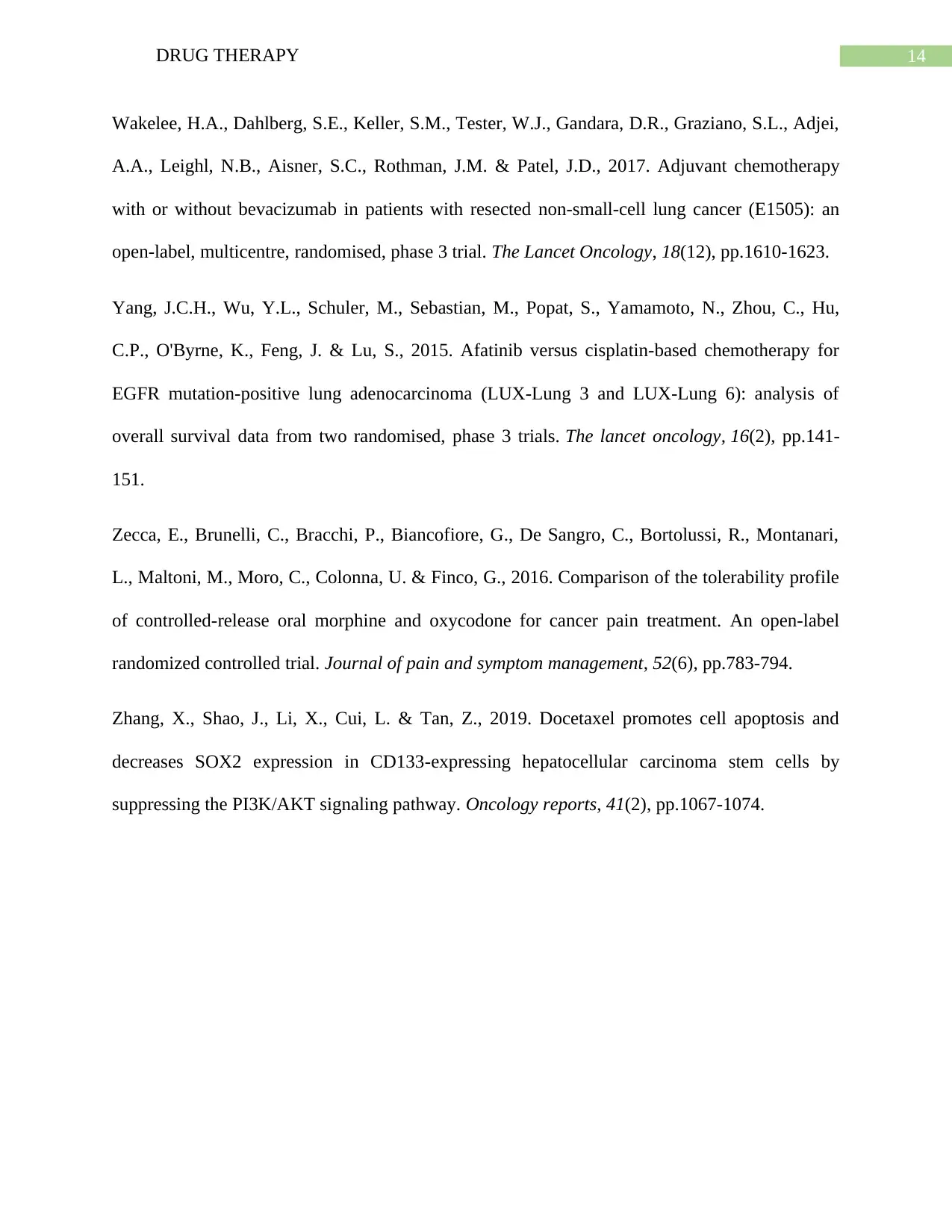
14DRUG THERAPY
Wakelee, H.A., Dahlberg, S.E., Keller, S.M., Tester, W.J., Gandara, D.R., Graziano, S.L., Adjei,
A.A., Leighl, N.B., Aisner, S.C., Rothman, J.M. & Patel, J.D., 2017. Adjuvant chemotherapy
with or without bevacizumab in patients with resected non-small-cell lung cancer (E1505): an
open-label, multicentre, randomised, phase 3 trial. The Lancet Oncology, 18(12), pp.1610-1623.
Yang, J.C.H., Wu, Y.L., Schuler, M., Sebastian, M., Popat, S., Yamamoto, N., Zhou, C., Hu,
C.P., O'Byrne, K., Feng, J. & Lu, S., 2015. Afatinib versus cisplatin-based chemotherapy for
EGFR mutation-positive lung adenocarcinoma (LUX-Lung 3 and LUX-Lung 6): analysis of
overall survival data from two randomised, phase 3 trials. The lancet oncology, 16(2), pp.141-
151.
Zecca, E., Brunelli, C., Bracchi, P., Biancofiore, G., De Sangro, C., Bortolussi, R., Montanari,
L., Maltoni, M., Moro, C., Colonna, U. & Finco, G., 2016. Comparison of the tolerability profile
of controlled-release oral morphine and oxycodone for cancer pain treatment. An open-label
randomized controlled trial. Journal of pain and symptom management, 52(6), pp.783-794.
Zhang, X., Shao, J., Li, X., Cui, L. & Tan, Z., 2019. Docetaxel promotes cell apoptosis and
decreases SOX2 expression in CD133-expressing hepatocellular carcinoma stem cells by
suppressing the PI3K/AKT signaling pathway. Oncology reports, 41(2), pp.1067-1074.
Wakelee, H.A., Dahlberg, S.E., Keller, S.M., Tester, W.J., Gandara, D.R., Graziano, S.L., Adjei,
A.A., Leighl, N.B., Aisner, S.C., Rothman, J.M. & Patel, J.D., 2017. Adjuvant chemotherapy
with or without bevacizumab in patients with resected non-small-cell lung cancer (E1505): an
open-label, multicentre, randomised, phase 3 trial. The Lancet Oncology, 18(12), pp.1610-1623.
Yang, J.C.H., Wu, Y.L., Schuler, M., Sebastian, M., Popat, S., Yamamoto, N., Zhou, C., Hu,
C.P., O'Byrne, K., Feng, J. & Lu, S., 2015. Afatinib versus cisplatin-based chemotherapy for
EGFR mutation-positive lung adenocarcinoma (LUX-Lung 3 and LUX-Lung 6): analysis of
overall survival data from two randomised, phase 3 trials. The lancet oncology, 16(2), pp.141-
151.
Zecca, E., Brunelli, C., Bracchi, P., Biancofiore, G., De Sangro, C., Bortolussi, R., Montanari,
L., Maltoni, M., Moro, C., Colonna, U. & Finco, G., 2016. Comparison of the tolerability profile
of controlled-release oral morphine and oxycodone for cancer pain treatment. An open-label
randomized controlled trial. Journal of pain and symptom management, 52(6), pp.783-794.
Zhang, X., Shao, J., Li, X., Cui, L. & Tan, Z., 2019. Docetaxel promotes cell apoptosis and
decreases SOX2 expression in CD133-expressing hepatocellular carcinoma stem cells by
suppressing the PI3K/AKT signaling pathway. Oncology reports, 41(2), pp.1067-1074.
1 out of 15
Related Documents
Your All-in-One AI-Powered Toolkit for Academic Success.
+13062052269
info@desklib.com
Available 24*7 on WhatsApp / Email
![[object Object]](/_next/static/media/star-bottom.7253800d.svg)
Unlock your academic potential
© 2024 | Zucol Services PVT LTD | All rights reserved.




